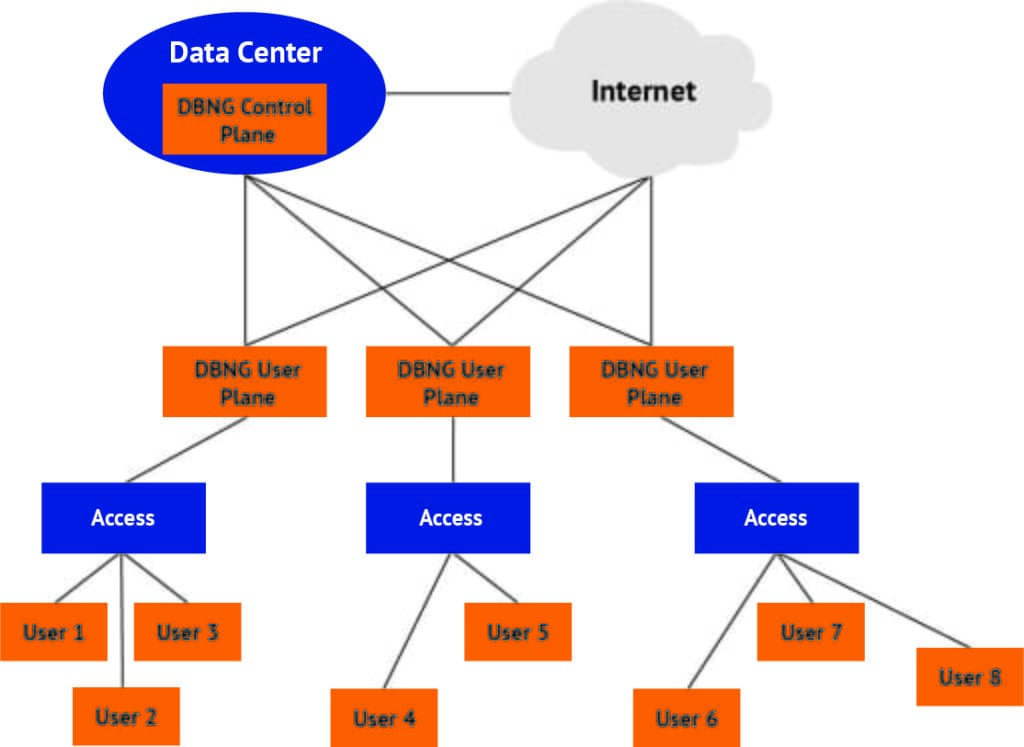Here is the second part of our two-part series on Disaggregated Broadband Network Gateway. Broadband Network Gateway (BNG) is an important network element that provides all the functions required to support managed subscriber broadband service.
The disaggregated control plane handles several functions, including:
- Subscriber session termination.
- PPPoE or IPoE(DHCPv4/DHCPv6/SLAAC packets) termination
- Authentication.
BNG control plane acts as AAA client and completes authentication by contacting AAA servers. The trigger to start authentication is the arrival of PPPoE or DHCP initial messages.
- IP address management
The control plane downloads forwarding rules to the user plane after finishing the IP address assignment.
- Accounting
- Usage information is exchanged with corresponding servers.
- PEP (Policy Enforcement Point)
- After receiving the policies, the control plane pushes these policies onto the user plane.
In the disaggregated world, the user plane performs traffic forwarding and policy enforcement on subscriber traffic. The control plane triggers the user plane to create states to manage forwarding and other SLA requirements. The following are the functions of a user plane.
- Traffic management: This includes header manipulation, subscriber session termination, forwarding rule processing, filtering rule processing, and QoS implementation. Examples are PPPoE and IPoE handling, IP forwarding, CNAT, L3/MPLS forwarding, TWAG, and traffic policing/shaping/rate-limiting.
- Subscriber packet statistics collection: This is a critical function, especially in terms of monetizing the usage.
- IPTV Multicast: Multicast packets are processed in the user plane to provide fast channel change.
- Subscriber routing: Includes both routing control and forwarding.
- Keepalive message processing: This functionality improves scalability and failure detection times.
- Lawful Intercept: The user plane component of lawful intercept where the mirrored packet must adhere to local country standard Lawful Intercept format.
- Local control plane: Since the user plane is a stand-alone entity, the processing of control messages like IGMP, MLD, IGP, BGP, and keepalives are an essential functionality.
A DBNG control plane can control multiple DBNG user planes from different vendors. The DBNG control plane is responsible for pushing the configurations and retrieving the operational states from these user planes. Control messages (like DHCP, PPPoE PADI) are also exchanged between the control plane and user plane. Since the control plane is decoupled from the user plane, access circuit information will get attached as metadata from the user plane to the control plane.
The DBNG uses the Packet Forwarding Control Protocol (PFCP) as CUPS (Control and User Plane Separation) protocol to communicate and maintain the required functions between control plane and user plane. PFCP is a 3GPP protocol specified in Technical Specification 29.244, which defines the interface between the control plane and the user plane function. PFCP contains two main message types: node messages and session messages. Node messages are mainly used to form the association between DBNG-CP and DBNG-UP. Session messages are used primarily for programming the subscriber forwarding state.
In a typical deployment, a DBNG control plane can be brought up in a data center while the user planes are deployed in different areas close to subscribers. This is shown in Figure 4. The data center deployment of the DBNG control plane makes it highly flexible in terms of scalability and performance. The user plane can also be virtualized in situations where the traffic is light. But high traffic scenarios usually need the user plane to be in physical boxes near to the subscriber.

Developing a reliable, feature-rich, and cost-effective DBNG requires a robust network operating system and the best forwarding plane. OcNOS is a robust, programmable, and innovative operating system, featuring a single software image that runs across the entire portfolio of Open Compute platforms from leading network device vendors. OcNOS can work as the DBNG control plane.
IP Infusion’s deep expertise with the StrataDNX®family of chipsets enables us to develop the best Disaggregated BNG user plane. StrataDNX Jericho2 Series includes the 5 Tbps Jericho2c, the 2.4Tbps Qumran2c, and the 800Gbps Qumran2a devices, delivering a comprehensive merchant-silicon portfolio of carrier-grade routing chipsets and enabling production network deployments. This series leverages a unified, fully scalable, and software-programmable packet-processing feature set based on the breakthrough Elastic Pipe™ architecture, enabling user plane functionality for DBNG.
These chipsets are capable of handling PPPoE MP and PPPoE P2P. PPPoE P2P mode is often used with L2TPv2 in a cross-connect scenarios. ®GTP termination and encapsulation is another critical feature supported. This can be leveraged to support 3GPP 5G user plane. Our active participation in forums, such as Open Networking Forum, Telecom Infra Project, BroadbandForum, and Open Compute Project, enables us to provide value-added solutions.

